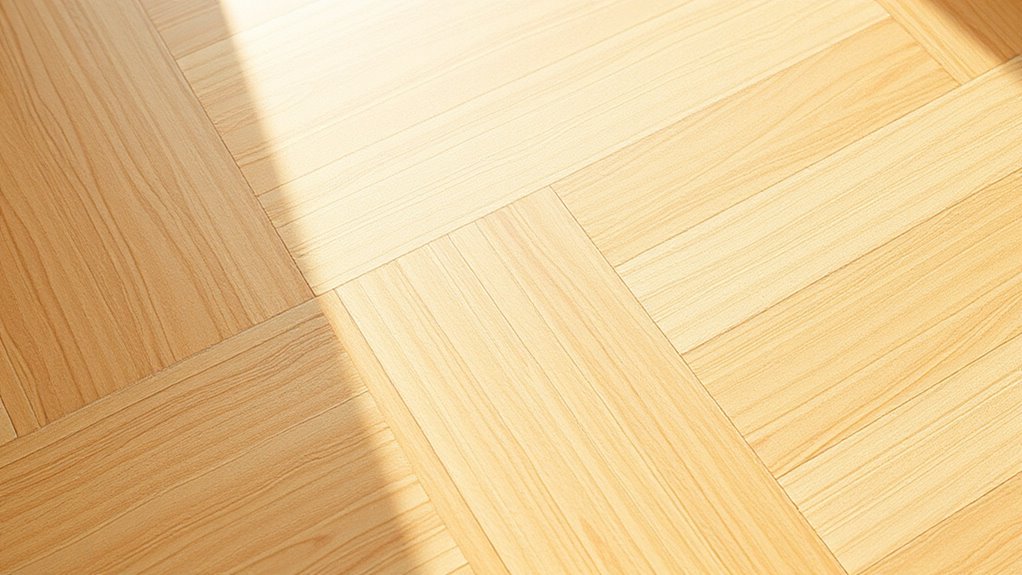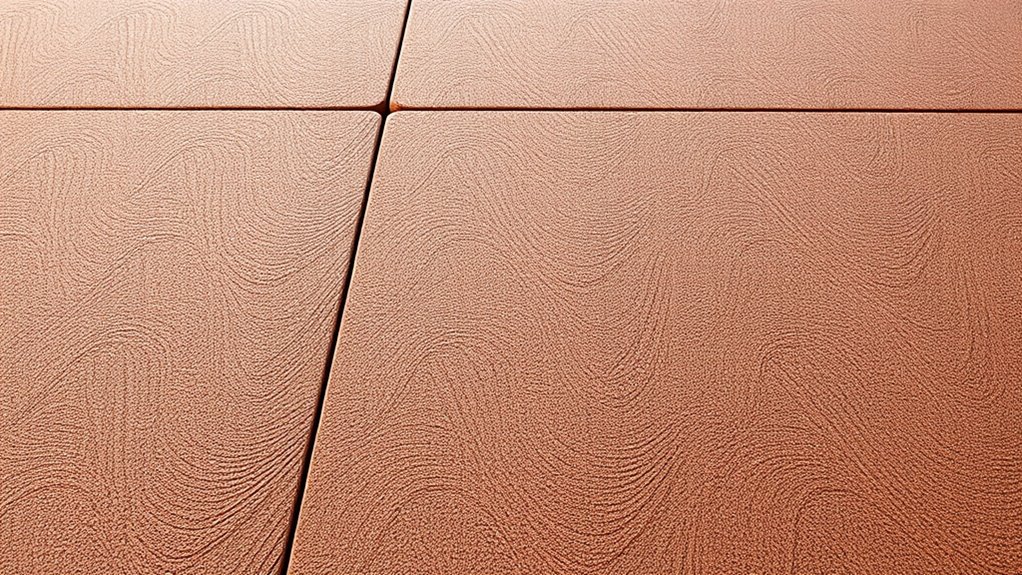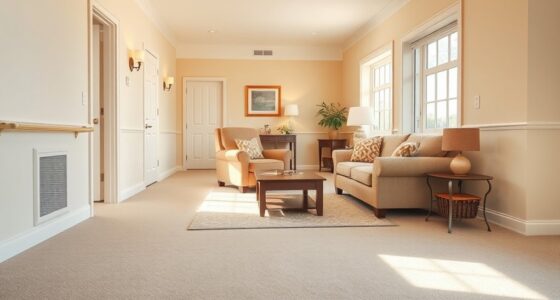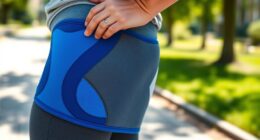If you’re looking for flooring that cushions without causing tripping hazards, consider options like rubber, cork, or low-pile carpet. Rubber flooring offers shock absorption and slip resistance, ideal for safety and comfort. Cork provides a springy surface that reduces impact and slips, while carpeted floors add plush cushioning and grip. Engineered floors with impact-absorbing underlays also work well. To find the best choice for your space, explore how these materials can transform safety and comfort for you.
Key Takeaways
- Rubber flooring provides durable, slip-resistant cushioning that minimizes tripping hazards and absorbs impact effectively.
- Cork flooring offers a natural, springy surface that reduces impact and helps prevent slips and trips.
- Carpeted flooring with low pile and slip-resistant backing creates a soft, safe walking surface with minimal tripping risk.
- Engineered and laminate floors with cushioned underlay soften footsteps and improve safety by reducing falls.
- Proper installation and regular maintenance of impact-absorbing flooring enhance safety and prevent tripping hazards.

Choosing the right flooring can make a significant difference in both comfort and safety, especially if you want a surface that cushions your steps without causing tripping hazards. When selecting flooring, consider materials that absorb impact and provide a gentle surface underfoot. Soft, resilient floors can reduce fatigue and protect joints, making them ideal for homes with children, elderly residents, or anyone who spends long hours standing. These options not only enhance comfort but also minimize the risk of slips and falls, creating a safer environment overall.
Selecting impact-absorbing, soft flooring enhances comfort and safety, reducing slips and protecting joints for all residents.
One of the most popular choices for cushioning and safety is rubber flooring. It’s highly durable, shock-absorbent, and slip-resistant, making it perfect for areas prone to moisture or heavy use. Rubber flooring’s flexibility allows it to absorb impacts, which can prevent injuries if you fall. Plus, it’s available in various colors and textures, so you can choose a style that complements your space. Installing rubber tiles or rolls is straightforward, and maintenance is simple, requiring only regular sweeping and occasional damp mopping.
Cork flooring is another excellent option for cushioning and safety. It’s a natural material that offers a soft, springy surface underfoot. Cork’s resilience helps reduce the impact on your joints and provides a natural grip that minimizes slips. It’s also environmentally friendly and naturally resistant to mold and mildew, making it suitable for homes and offices alike. Although cork can be more susceptible to scratches and dents, proper sealing and care can extend its lifespan and keep it looking good.
Carpeted flooring provides a plush, cushioned feel that’s comfortable to walk on. It’s particularly effective in bedrooms, living rooms, or areas where you spend a lot of time standing. Carpet offers excellent shock absorption, which can help prevent injuries from falls. However, it’s essential to choose carpets with low pile and slip-resistant backing to ensure safety and ease of maintenance. Regular vacuuming and prompt cleaning of spills will keep it looking fresh and safe.
Finally, engineered wood or laminate flooring with a cushioned underlay can also deliver some impact absorption while maintaining a sleek appearance. Underlay materials made of foam or rubber act as shock absorbers, softening footsteps and reducing noise. When combined with the right flooring material, this setup creates a comfortable, safe surface that’s less likely to cause trips or slips. Just make sure to choose underlays with anti-slip properties and install them correctly for maximum safety.
Frequently Asked Questions
How Durable Are Cushioned Flooring Options Over Time?
Cushioned flooring options are quite durable if you choose high-quality materials. You’ll find that many modern options resist wear and tear, maintaining their cushioning and appearance over years of use. Proper installation and regular maintenance also help prolong their lifespan. While softer floors may show signs of aging faster than harder surfaces, with good care, you’ll enjoy their comfort and safety for a long time.
Can Cushioning Flooring Be Installed Over Existing Surfaces?
Imagine walking into your space and discovering you can install cushioned flooring right over your existing surface. Yes, you can! Many cushioned flooring options, like vinyl or foam tiles, are designed for easy installation over various surfaces. Just make certain the existing floor is clean and level for the best results. This way, you get added comfort and safety without the hassle of removing your current flooring.
Are Cushioned Floors Suitable for Outdoor Use?
Cushioned floors are generally not ideal for outdoor use because they can be damaged by moisture, UV rays, and temperature fluctuations. If you want outdoor cushioning, look for specially designed rubber or rubber-like materials that are weather-resistant. These options provide some shock absorption and safety while standing up to outdoor elements. Always check product specifications to make sure the flooring is suitable for your outdoor space before installing.
What Maintenance Is Required for Cushioning Flooring?
You should regularly sweep or vacuum to remove dirt and debris, mop with a mild cleaner to maintain its appearance, and inspect for wear or damage. Address spills promptly to prevent stains or warping, and reapply protective coatings as recommended by the manufacturer. Keep your cushioning flooring in top shape by following these simple steps—cleaning, inspecting, and protecting—so it stays safe, comfortable, and durable for years to come.
How Do Cushioned Floors Affect Indoor Air Quality?
Cushioned floors generally improve indoor air quality by reducing noise and absorbing pollutants. However, some may emit volatile organic compounds (VOCs) from adhesives or foam materials, which can affect air quality. To guarantee a healthy environment, choose flooring with low VOC emissions, ensure proper ventilation during installation, and regularly clean the surface. Doing so helps you maintain a safer, fresher indoor space.
Conclusion
Think of this flooring as a gentle river guiding you smoothly along your day, never rushing or tripping over obstacles. It cushions your steps like soft moss underfoot, offering safety without sacrificing style. With this surface beneath you, every move feels effortless—like sailing on calm waters. Embrace the path that keeps you steady and secure, turning your space into a sanctuary where comfort flows effortlessly, and tripping becomes a thing of the past.









